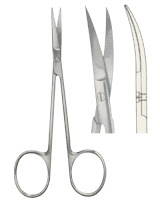Thumb forceps,
commonly called tweezers, are one of several types of forceps used in surgery. They are
mostly used to pick small objects and hold sensitive tissue. Thumb forcepsare used by holding them
between the fingers and squeezing them, which then closes the serrated tip.
Most forceps that are used in surgery are
made of either stainless steel or
disposable plastic.
They
are often used to pick up objects where using the fingers would not be ideal
for the job. This can be because the object is too small for the fingers to
hold, the object is in an area where the fingers would not fit, or the object
needs more precision during handling.
During
surgery, thumb forceps are usually used to move or hold tissue. Since forceps enable doctors to hold tissue
without direct contact, they can help prevent infection and minimize tissue
damage.
There
are two types of thumb forceps used to prevent infection. First are stainless steel
forceps, which
are made of stainless or high-grade carbon steel. Stainless steel forceps are designed to withstand high
temperatures from constant sterilization. Second are disposable forceps. Normally made of plastic to
cut costs, disposable forceps are used when the contamination cannot be removed by regular
sterilization.
To
minimize tissue damage, thumb forceps usually have specialized tips. A serrated or
"mouse teeth" tip does less tissue damage because the serration
enables the use of less pressure to grasp the tissue. Smooth and cross-hatched
tips are used primarily to remove dressings and sutures. By using forceps, the doctor is able to handle
dressings and sutures easier while preventing potential contamination from and
to the patient.
Unlike locking forceps such as Kelly and haemostatic forceps, thumb forceps belong to the non-locking type.
Non-locking types can only be used for holding and picking things because they
lack the locking mechanism used to hold the forceps in position. During surgery,
several types of forceps are utilized for different purposes. Locking forceps are used to control blood flow
by acting as a clamp to close off the veins; they also keep tissue in place,
thereby enabling the doctor to free his or her hands.
Non-locking forceps are used to move tissue around
and get a hold of hard-to-reach objects, such as when dental forceps are
used to remove molars. Thumb forceps have serrations on their grip to prevent
slippage. This is another distinguishable characteristic from locking forceps, which are held like scissors
and provide more stability.


